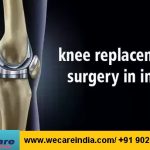CAROTID ARTERY STENOSIS SURGERY
Carotid stenosis is a narrowing or constriction of the inner surface (lumen) of the carotid artery, usually caused by atherosclerosis .
The carotid artery is the large artery whose pulse can be felt on both sides of the neck under the jaw. It starts from the aorta as the common carotid artery, and at the throat it forks into the internal carotid artery and the external carotid artery. The internal carotid artery supplies the brain, and the external carotid artery supplies the face. This fork is a common site for atherosclerosis, an inflammatory buildup of plaque that can narrow the common or internal artery.
Carotid artery stenosis can be a result of one or several factors. Plaque from cholesterol and fats can accumulate in the artery, creating a narrower pathway for blood flow. High levels of platelets in the blood can also form clotting in the arteries, blocking the path.
When a stroke is caused by artery stenosis, usually the artery has narrowed and platelets have accumulated at the narrow point to form a clot. As blood builds up behind the clot, the clot can eventually be passed into the brain. Additionally, the clot prevents blood from getting to the brain, and flow interruption, even if temporary, kills brain cells and can impair brain function.
What is the treatment?
The treatment for carotid artery stenosis depends upon the degree of blockage and the presence of symptoms. If the carotid artery is less than 70% blocked and you have no symptoms, doctors usually recommend aspirin treatment. One aspirin per day will reduce the likelihood of a blood clot and decrease your chance of stroke.
Your treatment will include regular checkups with your doctor to see if your condition changes. If the carotid artery is less than 70% blocked, but you have symptoms, the treatment depends upon the results of the cerebral arteriogram. If this test shows no other problems, patients are usually started on daily aspirin treatment. Again, treatment will include regular checkups for any changes in your condition. However, if the plaque looks rough and irregular, your doctor may recommend surgery to remove the plaque. If the carotid artery is more than a 70% blocked and you have symptoms, the usual treatment is surgery.
This procedure, called carotid endarterectomy, involves removing the plaque from the carotid artery. You are placed under general anesthesia and the surgeon makes a small cut (incision) in your neck to expose the artery. He or she then makes a cut in the artery and removes the blockage. The artery is repaired and the incision in your neck is closed with stitches. Following the surgery, you may need to take medicine that makes your blood less likely to clot. There is a one to two percent risk of stroke with this procedure. Another promising procedure is called carotid angioplasty. With this procedure, the area around the carotid artery is numbed with a local anesthetic. Then, a long, thin tube, called a catheter, is passed into the carotid artery in the area of the blockage. The catheter has a balloon on its tip. When the balloon is inflated, it stretches and opens the blocked artery.
Diagnosis Surgery in india
Carotid stenosis is usually diagnosed by colour flow duplex ultrasound scan of the carotid arteries in the neck. This involves no radiation, no needles and no contrast agents that may cause allergic reactions. This test has moderate sensitivity and specificity, and yields many false-positive results.
Typically duplex ultrasound scan is the only investigation required for decision making (including proceeding to intervention) in carotid stenosis. Occasionally further imaging is required. One of several different imaging modalities, such as angiogram, computed tomography angiogram (CTA) or magnetic resonance imaging angiogram (MRA) may be useful. Each imaging modality has its advantages and disadvantages – the investigation chosen will depend on the clinical question and the imaging expertise, experience and equipment available.
What Medical Procedures Treat Carotid Artery Disease?
If there is severe narrowing or blockage in the carotid artery, a procedure can be done to open the artery. This will increase blood flow to the brain to prevent future stroke.
Your doctor may suggest either of the following procedures : –
- Carotid endarterectomy (CEA) : – This has been the commonly performed procedure for patients who have carotid atherosclerosis and TIAs or mild strokes. While you’re under general anesthesia, an incision is made in the neck at the location of the blockage. The surgeon isolates the artery and surgically removes the plaque and diseased portions of the artery.
- Carotid artery stenting (CAS) : – Carotid artery stenting (CAS) is a newer treatment option. It’s less invasive than carotid endarterectomy and is performed in a catheterization laboratory. With CAS, a small puncture is made in the groin. A specially designed catheter is threaded to the area of narrowing in the carotid artery. Once in place, a small balloon tip is inflated for a few seconds to open the artery. Then, a stent is placed in the artery and expanded to hold the artery open. A stent is a small stainless steel mesh tube that acts as a scaffold to provide support inside your artery. The stent stays in place permanently. CAS is still a new procedure and there is significant controversy as to how well it prevents strokes caused by carotid artery disease.





